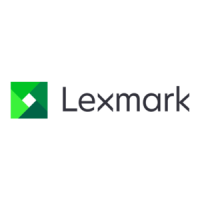
Do you have a question about the Lexmark E260dn Series and is the answer not in the manual?
| Print Technology | Monochrome Laser |
|---|---|
| Duplex Printing | Standard |
| Paper Input Capacity | 250 sheets |
| Paper Output Capacity | 150 sheets |
| Resolution | 1200 x 1200 dpi |
| Memory | 32 MB |
| Connectivity | USB 2.0, Ethernet |
| Media Sizes Supported | A4, A5, A6, Executive, Letter, Legal, Statement, Universal |
| Media Types Supported | Plain Paper, Card Stock, Transparencies, Envelopes, Paper Labels |
| Operating System Compatibility | Microsoft Windows, Apple Mac OS, Linux |
| Dimensions | 378 x 391 x 259 mm |
| Weight | 14.0 kg |
| Recommended Monthly Page Volume | 250 - 2, 500 pages |
Groups critical safety precautions, shock hazards, and potential injury warnings.
Covers locating setup information and using the help system.
Details how to get telephone and email support from Lexmark.
Explains basic and configured printer models and their parts.
Describes the layout and function of the printer's control panel buttons and lights.
Provides guidelines for printer placement and ventilation requirements.
Details accessing the system board to install internal components like network cards.
Step-by-step instructions for installing an optional memory card into the printer.
Guides the user through installing optional paper drawers like the 250- or 550-sheet tray.
Explains how to connect the printer to a computer or network using various cables.
Provides instructions for installing printer drivers and software on Windows and Macintosh.
Explains the meaning of primary light patterns for printer status and errors.
Details secondary error codes indicated by specific light sequences on the printer.
Describes secondary light sequences indicating paper jam locations and clearing procedures.
Instructions for configuring tray settings to match loaded paper size and type.
Guides on defining custom paper sizes for the printer using width and height measurements.
Step-by-step guide for loading paper into the printer's standard tray (Tray 1).
Instructions for loading paper into optional 250- or 550-sheet trays (Tray 2).
Explains how to use the manual feeder for single-sheet printing.
Describes how to use the standard exit bin and paper stop for managing printed output.
Lists the paper capacities for the printer's trays and manual feeder.
Explains how to link and unlink paper trays for automatic paper feeding.
Guides on naming custom paper types for tray linking and unlinking configurations.
Details paper characteristics like weight, curl, smoothness, and grain that affect print quality.
Provides tips for selecting appropriate paper to avoid jams and ensure good print quality.
Guidelines for using preprinted forms and letterhead with the printer.
Information on the characteristics and use of recycled paper in laser printers.
Recommendations for proper paper storage to prevent jams and ensure print quality.
Tables detailing supported paper specifications for various printer input sources.
Step-by-step instructions for printing documents from Windows and Macintosh.
Explains how to perform automatic and manual duplex (two-sided) printing.
Covers printing tips for letterhead, transparencies, envelopes, labels, booklets, and information pages.
Guides on printing test pages to diagnose and isolate print quality issues.
How to configure the printer to reprint pages after a paper jam occurs.
Procedures for canceling print jobs from the printer control panel or computer.
How to access and navigate printer settings via the Embedded Web Server.
Instructions for installing the utility to manage printer settings locally.
How to use the utility to configure printer settings and save them as command files.
Details settings for default paper source, size, and type across different trays.
Options for selecting paper texture to optimize print quality.
Options for specifying paper weight for different media types.
Settings related to paper loading and duplex printing configurations.
How to define and manage custom paper types for specific media.
Configure custom paper sizes by specifying units, width, height, and feed direction.
Covers general settings like display language, eco-mode, and quiet mode.
Options for setting printer language, print area, and download targets.
Settings for duplex binding, copies, collation, separator sheets, and N-up printing.
Adjustments for print resolution, toner darkness, fine lines, and gray correction.
Settings related to PostScript error printing and font priority.
Options for PCL emulation, including font source, pitch, and orientation.
Configuration for network interfaces, TCP/IP, IPv6, AppleTalk, USB, and parallel ports.
Settings for PCL/PS switching, network buffer, and Mac binary PS.
Options to view network card status and speed.
Configuration for TCP/IP settings like activation, hostname, IP address, and DHCP.
Settings for IPv6 configuration, auto-configuration, and DHCPv6.
Options to activate and configure AppleTalk support.
Settings for USB port configuration, including PCL/PS switching and buffer size.
Settings for parallel port configuration, including PCL/PS switching and buffer settings.
How to view printer messages through the virtual display on the Embedded Web Server.
Explains various status and error messages displayed by the printer.
Tips and best practices to prevent paper jams in the printer.
Identification of all possible areas within the printer where paper jams can occur.
Links jam light sequences to specific jam access points for easier resolution.
Detailed steps for removing paper jams located behind the toner and photoconductor unit.
Instructions for removing paper jams from the printer's standard output area.
Steps to clear paper jams located in or behind the standard paper tray (Tray 1).
Instructions for removing paper jams from the optional paper tray (Tray 2).
Procedures for clearing paper jams that occur in the manual paper feeder.
Steps for clearing paper jams accessible from the printer's rear door.
Initial checks for common issues like power, connectivity, and software installation.
Addresses issues like jobs not printing, incorrect characters, slow printing, and collation errors.
Solutions for when print jobs fail to start or complete.
How to print PDF documents with unavailable fonts correctly.
Advice on reducing print job complexity to speed up printing.
Troubleshooting steps for when garbled or incorrect characters appear in printouts.
Solutions for problems encountered when paper trays are linked or unlinked.
Steps to ensure collated output for multiple copies or large print jobs.
Addresses issues with installed printer options not functioning correctly.
General troubleshooting for printer options that quit or operate incorrectly.
Solutions for problems related to printer paper drawers or feeders.
Troubleshooting steps for problems with installed memory cards.
Covers frequent paper jams and issues with jam lights remaining on.
Causes and solutions for recurring paper jams in the printer.
How to clear residual jam indicators when the paper path is clear.
Comprehensive guide to diagnosing and fixing various print quality issues.
Guides on using print quality test pages to identify specific print defects.
Solutions for when the printer outputs blank pages instead of print content.
Troubleshooting for printouts where text or graphics have rough edges.
Solutions for images or text that are cut off or truncated on the printed page.
How to reduce or eliminate unwanted gray backgrounds in printouts.
Solutions for faint repeated images appearing on the printed page.
How to correct print margins that are not set correctly.
Addresses issues caused by paper curling during or after printing.
Solutions for printouts where the text or images are excessively dark.
Troubleshooting for printouts where text or images are too faint.
Solutions for printed pages where the content is misaligned or crooked.
How to resolve print defects showing unwanted toner deposits.
Solutions for toner that smudges or rubs off the printed page.
How to eliminate small, scattered toner dots appearing on printouts.
Tips for improving print quality when using transparencies.
Solutions for print defects appearing as horizontal lines on the page.
How to resolve print defects appearing as vertical lines on the page.
Troubleshooting for solid black or white streaks on printed media.
Information on how to contact Lexmark support for unresolved issues.
Details about the printer model, machine type, and available models.
Legal disclaimers and copyright information regarding the publication.
Legal statements regarding software rights and company trademarks.
Compliance statement for FCC regulations regarding radio frequency emissions.
Compliance information related to Industry Canada standards for digital apparatus.
Information on the product's conformity with EC directives for electromagnetic compatibility and safety.
Safety information regarding radio frequency exposure limits and minimum separation distances.
Measurement of sound pressure levels during different printer operating modes.
Information regarding the recycling of electrical and electronic equipment.
Warning about handling static-sensitive parts within the printer.
Information regarding the printer's certification as a Class I laser product.
Details the power consumption of the printer in various operating modes.
Explanation of the energy-saving mode and how to adjust the power saver timeout.
Outlines the terms and conditions of the Lexmark product warranty.
Details the warranty coverage, exclusions, and service procedures.
Information on how to obtain warranty service and the process for exchange.
Defines what is not covered by the limited warranty and common causes of failure.
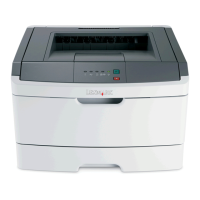
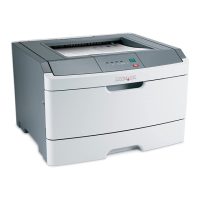
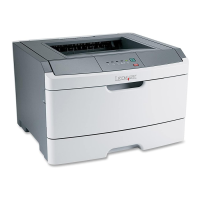
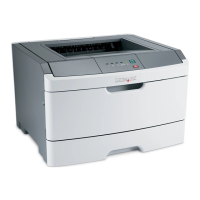
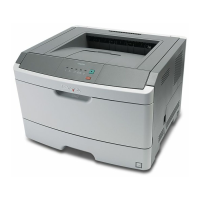
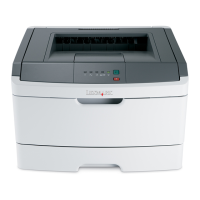


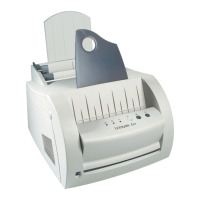
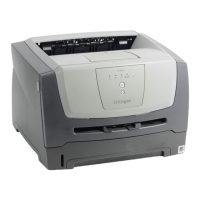
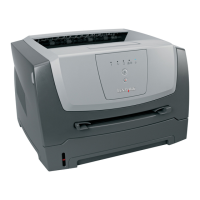

